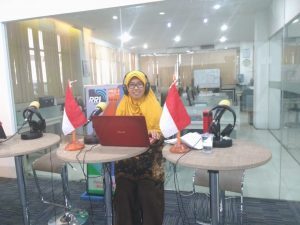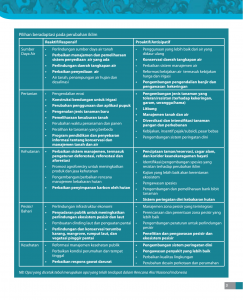Climate Change
Information
LIVE RRI, Friday NOVEMBER 9th 2018
By : Wien Lestari, ST., MT
Lecturer in Geophysical Engineering ITS and member of Pusat Studi Kebumian, Bencana dan Perubahan Iklim
(PS-KBPI LPPM ITS)

Indonesia has experienced a series of disasters that have resulted in fatalities, environmental damage and infrastructure such as Jakarta floods, landslides in Banjarnegara and Ponorogo, tornadoes in Surabaya, landslides in Lumajang, tidal floods in Semarang, high waves on the southern sea, even such global disaster like melting ice , extreme storms, heat waves and tornadoes. Disasters occur not only because of climate change which become extreme, but also the environmental damage and the geography of the region itself. Areas with high topography must be vigilant about rainfall because the intensity can trigger landslides when they are not supported by environmental forces (trees with strong roots) to hold them back. Urban areas are prone to floods if they do not have a good drainage and good river management systems and good people’s lifestyles in waste management. In addition, there is a shift in seasons such as a longer dry season, a long rainy season with a small or even sudden extreme intensity.
It is important to educate public in dealing with climate change in the form of adaptation actions (Adaptation to conditions) and mitigation (disaster risk reduction). Climate change is a change in the natural elements of the climate (temperature, humidity, rain, pressure, wind, etc.) in a relatively long time and the natural things of the earth’s stability cycle. The Intergovernmental Panel on Climate Change (IPCC), an international forum, states that the biggest source of climate change is due to increasing global surface temperature. Global warming occurs because of the increasing concentration of greenhouse gases in the atmosphere. Greenhouse gases are naturally obtained from sources of evaporation and eruption, in normal concentrations to warm the earth, but the IPCC in 2007 issued a statement that the main cause of increasing global warming is the human activities that result greenhouse gases. Greenhouse gases will reflect solar radiation back to earth so that the earth’s temperature rises. Greenhouse gases are generated in almost all sectors of activities that use fossil fuels, organic waste, cooling materials in electronic devices. The biggest impact of greenhouse gas come from Carbon dioxide (CO2), Nitro Oxide (NOx), Sulfur Oxide (SOx), Methane (CH4), Chloroflurocarbon (CFC), Hydrofluorocarbon (HFC).
BMKG Surabaya stated the information there was an increase in temperature of 1° C every year in the last 40 years in Surabaya, so it became an early warning to mitigate the reduction of CO2 emissions that could trigger extreme climate change. Indicators of climate change according to the Rencana Aksi Nasional (RAN) towards climate change arranged by BAPPENAS, such as
|
Climate Change Phenomenon |
Impact |
Sector In Iccsr |
| Rising Sea Surface Level
|
Puddles in coastal areas | Watery, Fishery and Ocean, Health |
| Sea Water Intrusion | Watery, Agriculture | |
| Climate Change | River flooding | Watery, Health |
| Puddle | Watery, Agriculture, Health | |
| Water Pollution | Watery, Health | |
| Dengue Fever, Diarrhea, Malaria | Health | |
| Rising Air Surface Temperature
|
Dengue Fever, Diarrhea, Malaria | Health |
| Drought | Air, Agriculture, Health | |
| Lacking of Clean Water | Air, Agriculture, Health | |
| Hot temperature | Agriculture, Health | |
| Extreme Climate | Storm | Agriculture, Fishery and Ocean |
| Tornado | Health |
Then if we look through global warming in Indonesia in terms of environmental, social, economic, health and cultural aspects, we can describe as follows:
- Food Stability is in threat – Agricultural and Fishery Production will be decreased due to flooding, drought, warming and water pressure, pest and disease attacks, rising sea water, and strong winds. Climate change will also affect the planting time and harvest time, it causes the planting time in some places become longer but in other places it becomes shorter. An increase in temperature of 1o C is expected to reduce the rice harvest in tropical countries by 10%. Thus the danger of starvation will threaten the population anywhere.
- Health Risks – Extreme weather will accelerate the spread of new diseases and can cause old diseases that are rarely found now. The United Nations Health Agency estimates that the increase in temperature and rainfall due to climate change has caused the deaths of 150,000 people every year. Diseases such as malaria, diarrhea, and dengue fever (dengee) are predicted increasing in tropical countries like Indonesia.
- Water – Water availability reduced by 10% -30% in some regions, especially in arid tropics. Water scarcity will afflict millions of people in Asia Pacific due to prolonged dry season and sea water intrusion to the mainland. People who live along the coast will suffer greatly.
- Economy – The loss of productive land due to high sea level, droughts, disasters, and health risks has an impact towards economy condition. Sir Nicolas Stern, advisor to the British prime minister stated that in the next 10 or 20 years climate change will have a major impact on the economy. Stern said that the world must try to reduce emissions and help poor countries to adapt towards climate change for the sake of economic growth. He explained that an investment of 1% of total world income is needed to prevent the loss of 5% -20% of future income due to the impact of climate change.
- Social, cultural and political impacts – Disasters caused by climate change will increase the number of refugees within a country or between countries. The refugees have no option but turn to be poor and separated from their social and culture, especially related to their ancestral lands and cultural wisdom. On the other hand, the food, water and resource crisis continues to increase, and it leads to horizontal conflict and can eventually trigger political conflict not only within the country but also between countries.
- Environmental Impact – extinction. Animals and plants will find difficulties to avoid the effects of global warming because most of the land will be inhabited by humans. Plants will change their growing direction, looking for new areas due to their old habitats are too warm. Many types of living things will be threatened with extinction due to climate change and disruption to the sustainability of ecosystem areas (ecosystem fragmentation), for example coral reef will lose its colour due to hot weather, become damaged or even die due to high temperatures. The researchers estimate that 15% -37% of all species could become extinct in six regions of the earth by 2050. The six regions studied represent 20% of the earth’s surface.
- Impact of Climate Change on Agriculture and Fisheries – Based on data and information from several climate and weather institutions and researchers, global climate change has affected agriculture and world fisheries
Indonesia and other countries in the world have committed (the Tokyo Protocol 2007) to reduce greenhouse gas emissions by 20%, which has been reduced in the National Action Plan and downgraded to regional and long-term regional development plans. All levels and places and ages can contribute and do not need to wait for command from the government. Experience every year, records of natural events, local wisdom and observations of the environment should be the primary material for carrying out adaptation and mitigation activities to climate change. Mitigation is an effort to reduce greenhouse gas emissions as a response to climate change issues, for example the use of bicycles as a mode of transportation, carbon emission calculation. Adaptation is an effort to increase resilience to the effects of climate change, for example: improving the quality of infrastructure, improving service quality and so on.
Any mitigation actions can be carried out such as:
- Save electricity usage : a) Use energy saving lights ; b) Choose electronic devices such as rice cooker, etc whose capacity suitable with our household needs, ; c) Use a washing machine according to its maximum capacity, so it doesnt work little by little laundry; d) Turn off electronic devices that are not being used; e) Try a well-ventilated house so that it is not too depend with Air Condition (AC); f) Give the house optimal sunlight so that it doesnt need more lights during the day
- Save paper and ink usage : a) For the purpose of writing concepts / scribbles, you shouldnt use the new paper, better use the used paper, b) Limit the use of disposable products such as: tissue, diaper / pampers, and so on. c) Used paper is collected and given to scavengers.
- Save on water usage: a) When using a shower or wash, turn off the faucet when you shave, brush your teeth and dry it, in this way you can save up to more than 6000 L of water per week; b) Collect used water such as the water used for washing vegetables, we can utilise it for watering the plants, and so on; c) Do the car wash using bucket not water tap; d. Check regularly and replace the faucet or water pipe that starts to leak, you can save up to 9500 liters of water per month.
- Save fuel use : a) Take a good care of your vehicle’s engine; b) Check your vehicle’s tire pressure, accurate tire pressure can save fuel; c) Avoid using vehicles which has inefficient combustion system; d) Use the vehicle as needed, when it comes to travelling alone, riding motorcycle is better than car;
- Good waste management : a) Separate between organic and non-organic waste, because organic waste can be composted; b) Organic waste can be made as filling material for bio pore; c) Avoid burning trash; d) When it comes to shopping, bring your own shopping bag, avoid using plastic bags.
In Surabaya, ITS as ”eco-campus” has implemented several activities including the application of e-office, waste processing, the use of energy-saving lamps, solar energy, campus bike, vehicle emission testing, utilisation of mass transportation and others. Then schools, offices, industries and other places of course have also implemented environmental policies in the implementation of their operations.
Adaptation actions that can be applied include the following points (www.worldbank.org) :

Climate change and global warming are real in front of us. For our earth which is the one and only, let’s be active and give contribution to our environment as best as we can, no need to wait for command from government. Bring good habits to protect the environment, start from early age and inherit the best lifestyle for next generation.
Latest News
-
Beradaptasi dengan Sesar Aktif Penyebab Gempa Darat, Belajar dari Gempa Myanmar
1. Belajar dari Gempa Myanmar Jumat, 28 Maret 2025, pukul 13:20:56 WIB wilayah Mandalay, Myanmar, diguncang gempabumi tektonik. Gempa
-
Kembangkan Deep Nueral Network dan IOT Dalam Carbon Capture Storage, Mahasiswa Teknik Geofisika ITS Sabet Juara 2
Dua Mahasiswa Teknik Geofisika ITS berhasil menjuarai kompetisi nasional INCEPTION 2025. Dimas Xavier Saivascello (5017241010) dan Luvin Diart Lazertino
-
Mahasiswa Teknik Geofisika ITS Sabet Juara 1 Petrowell Study Case Competition
Tiga Mahasiswa Teknik Geofisika ITS berhasil menjuarai kompetisi nasional di bidang Oil & Gas. Tim mahasiswa yang terdiri E.T.A.





